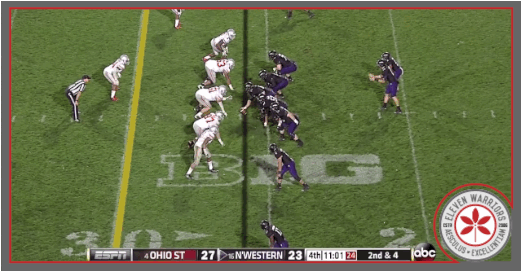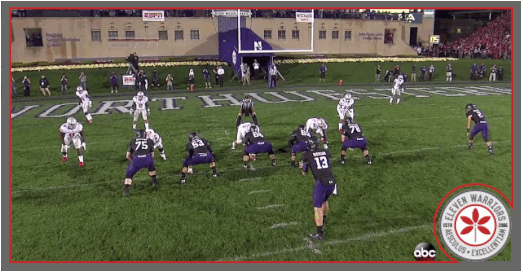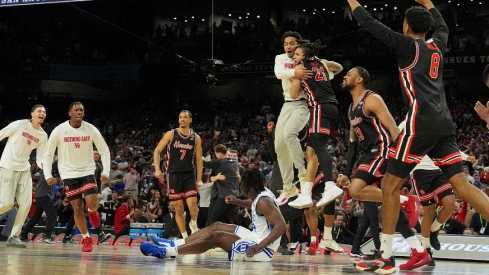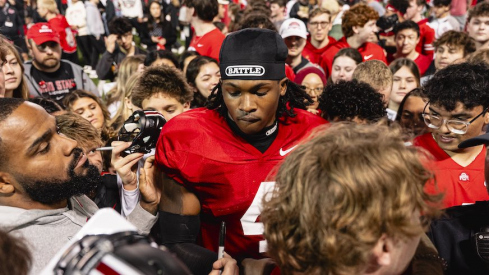
The Ohio State defense has been nothing if not inconsistent throughout the season's first half. The Buckeyes have stopped the run against several quality offenses and have made crucial stops. The Buckeyes are also benefiting from extremely efficient special teams play.
But Ohio State's defensive efforts have been undermined by a porous pass defense. The Buckeyes are permitting .29 points per play (worse than their peer competitors), often as a result of allowing chunk yardage in the passing game.
This is partly reflective of a focus on the run, but also a result of perplexing coverage breakdowns. The Buckeye defensive staff must coalesce around a consistent philosophy and put a greater reliance upon their young, but talented, defensive line.
Below I address the Buckeyes' coverage philosoph(ies), the breakdowns in pass defense, and how Ohio State can try to fix the pass coverage.
Where Did that Come From?
In 2012, Ohio State primarily played cover 4 on first and second down against spread formations. But 2013 has been an entirely different story. Cover 4 has largely been abandoned. In its place is an emphasis upon single high safety cover 3.

The extensive use of cover 3 likely serves three purposes. It allows the Ohio State defense to bring an eighth defender, often strong safety CJ Barnett, into the box against the run while still having three deep defenders.
Playing cover 3 also provides the Buckeyes a more consistent coverage scheme. In 2012, Ohio State would largely play single-high coverage against pro-style teams and cover 4 against the spread. The Buckeyes now appear comfortable playing cover 3 against any offensive scheme. Finally, from a single high safety look the Buckeyes can also play cover 1 man without disclosing the coverage pre-snap, as both leave the free safety in the deep middle of the field.

Plugging One Hole...
Applying an extra defender against the run has enabled the Buckeyes to shut down effective run games such as Wisconsin. But the Buckeyes' passing defense has struggled. Paradoxically, this could reflect the coaching staff's trust in an experienced secondary vis a vie a young defensive line and linebackers. The coaching staff feels more comfortable applying an additional defender against the run because of its secondary experience, particularly at corner.
Wisconsin is a concrete example of this paradox in action. The Buckeyes primary concern was limiting Wisconsin's 1) inside run and 2) jet sweep game. To do so, the Buckeye coaching staff placed a large amount of responsibility upon corner Bradley Roby, having him shadow Jared Abbrederis across the field as well as be responsible for providing force support against the jet sweep.
Ohio State accomplished its primary goal in stopping the run, but at the expense of Wisconsin gaining chunk yards in the passing games. At times this came against Roby in man coverage, but as often against holes in Ohio State's zone schemes.
But the Other Hole Has Holes
A focus upon the run game does not excuse the Buckeyes' coverage faults, however. The primary problem is allowing explosive plays in the passing game. Ohio State is near the bottom quarter of college football in allowing completions longer than 10 yards and 40 yards.
Urban Meyer and Everett Withers correctly pointed out several of the defensive deficiencies that are leading to long pass plays during their Monday press conference. Many of them boil down to recognition and technique.
With cover 3, the Buckeyes' corners are responsible for the deep third, so they will often play off-coverage. This results in a weakness in the underneath flats and permits an offense to throw quick receiver routes. While perhaps frustrating, this does not result in big pass plays. For over a decade, the Buckeyes based from cover 3 and were one of the best defenses in the country at preventing explosive plays.
The problem, as Withers pointed out, is not necessarily where the defensive backs align but how tight of coverage pass defenders play once patterns distribute within their zone. Merely because it is zone coverage does not mean you cannot cover receivers within those zones.
Once the ball is thrown, defenders must trigger, meaning they must quickly recognize what is going on with the pass pattern so that they can take a proper angle and tackle. Five yard hitch routes do not hurt if you make the stop. Offenses struggle to drive the length of the field without explosive plays. But such throws do become problematic when defensive backs are slow in recognition and then miss tackles.
For instance, Northwestern's only second half touchdown was engendered by a 60+ yard play off a simple slant route against cover 3.

As Withers described the problem on the play.
Well, a lot of it is, when we are playing thirds coverage and we are using what we call a clue technique, where the corner has to clue two to one, he has to stay on top and stay square. So if two goes to the flat, he's on top of one. If one and two go vertical, he's got to split them and we have to help him with a little bit of reroute on number two. That particular play, we needed a corner on top, we needed for C.J. to intercept the ball because they throw into buzz coverage.
In other words, Barnett was responsible for taking away that throw in his underneath cover 3 hook to curl zone. At worst that pass should have been a 8 yard gain, if not an interception. But Barnett was too slow in recognizing the slant-shoot combination that required Roby to stay on top of the throw. To compound matters he took a poor angle, resulting in a big game.
The other primary problem, as Meyer stated, is the underneath coverage from Ohio State's linebackers and star. The Buckeye underneath zone defenders are failing to re-route receivers, get proper depth, and then trigger on throws. As Withers' referenced, the failure to do so is allowing teams to throw vertical seam routes before the safeties can play the football. Below, Curtis Grant allows the seam route to run free, permitting an easy touchdown.

The Only Stability is Instability
At a deeper level, the Ohio State defense seems stuck in a never-ending tug of war as to how aggressive to play. This seemingly results in differing play calling not only game to game but series to series. The Wisconsin game is an apt example. Roby has played boundary corner his entire career. But for one game Ohio State asked him to play an entirely different role. A similar tension was at play against Northwestern. Ohio State varied between aggressively blitzing and playing man coverage to rushing three and dropping eight.
It goes without saying that a defense needs to vary the looks it provides the offense. But a defense must have a philosophy that players buy into and continually rep to provide stability. Defenses can be successful using either an aggressive or bend but don't break philosophy. But you must build your defense around one or the other. The Ohio State defensive coaching staff has struggled to find such a formula.
So Now What?
The bye week thus came at an opportune time for the Ohio State coaching staff to try and settle on a consistent formula. The simplest adjustment is to place a greater reliance upon the defensive line in both the run and pass game. While it made sense to protect a young front against the run, the defensive line is proving to be a strength, requiring less aggressive defensive back support.
Similarly, the Buckeyes need their burgeoning pass rush to take pressure off the coverage. As I noted, given the personnel it makes little sense for Ohio State to use three man rushes because the zone defense is insufficiently tight. Against Northwestern and Wisconsin, the Buckeyes' pass efficiency was far better when it forced the quarterback to throw quickly.
The Buckeyes should also determine how it wants to approach coverage in terms of style. There is not necessarily a right or wrong answer to whether the defense is better basing from a zone such as cover 3 or man coverage. But the coaching staff needs to choose a consistent framework. The defensive staff continually seems to dip their toes in man coverage, only to retreat back to zone. Ohio State ultimately needs to figure out what formula works with the personnel available and commit to that game plan. To that end, Withers suggested that one possible change to replace the loss of Christian Bryant is to move star Tyvis Powell to free safety with freshman Vonn Bell coming in at star.
In sum, the challenge for the Ohio State coaching staff is pulling together a strategy that minimizes the passing game missteps while maintaining what is working. Despite the miscues the Buckeye defense has been successful in several areas, primarily in stopping the run and on third down. Meyer suggested he believes that the defense found a way to strike that balance over the bye week, making defensive adjustments against Iowa a point to watch for.

